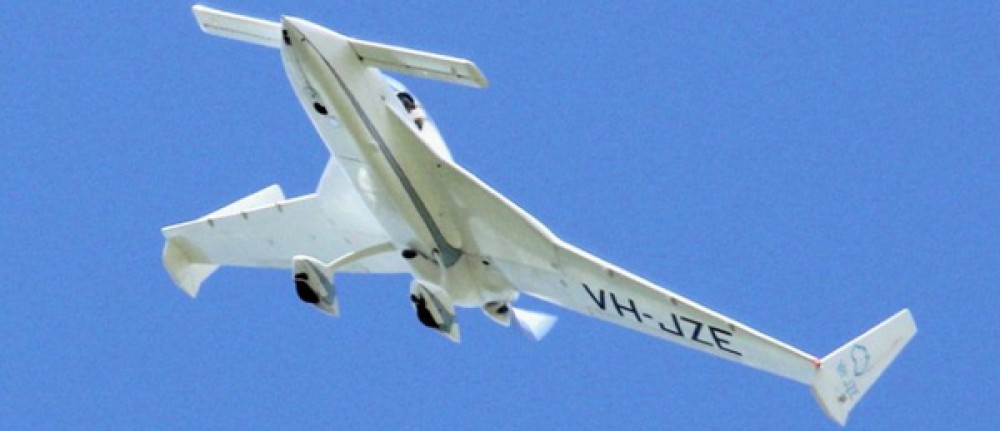With my having been crazy busy over the past 6 or so weeks as I focused on Jess and mine’s wedding (and subsequent honeymoon), this post covers a smattering of tidbits back from the very beginning of May.
First up, here we have the floxed and glassed Clickbonds on the right outboard corner where the CS spar meets the inboard right wing root. These Clickbonds will secure the front lip of the forward wing root heat shield that will also serve to keep hot engine compartment air/cooling air from flowing down this interface channel betwixt wing and CS spar.
Also from early May is the completed install of the Clickbonds on the left side of the CS spar for the same purpose:
To gain access to do the work above, I had removed the engine and had it hanging on the engine hoist. To ensure the hydraulic cylinder didn’t bleed down over time, I secured a 2×4 to the cylinder with tie-down straps to ensure that the hoist arm wouldn’t lower over time, to avoid my engine ending up on the shop floor.
Over a couple of weeks the engine did drop a little, but I chalked that up to hoist flange merely biting into the wood a little bit more. As another week passed, I then found something even a bit more insidious going on: the 2×4 was acting as a fulcrum, the engine was lower by a good bit more, and the wheels of the engine hoist on the opposite end were off the ground by a good 2-3″ (pic 1).
To solve this weird engine-hoist predicament, a few weeks into May I merely transferred the engine back onto the rolling engine stand and called it good… pic 2 (with more components now on the front [accessory case] of the motor I had to plasma cut some notches in the steel engine mount frame that was pre-mounted on the rolling engine stand).
I will also note that at the end of April my “little” buddy came over a few different days and really helped me in removing nearly everything out of the 2 far bays, blowing off and wiping all the micro dust off —again: everything— before it coming back into the shop. We got both bays 2 and 3 cleaned out very well, but alas, Bay 1 (long work table and machining tools) is still dusty and cluttered.
I don’t have any pics, but last week I spent a few good hours sanding down the epoxy wiped micro fills on the aft ends of the aft wheel pants, as well as the epoxy wiped micro on the front half wheel pants… that was a good workout by itself.
Fast forward to this past week, where my main focus is finalizing the sanding of all the epoxy wiped areas that I never got a chance to sand, and prepping the exposed CS spar “wings” inside the engine compartment for a ply of Fiberfrax to then be covered by aluminum as a protective overlay to the Fiberfrax (firewall will be Titanium).
I took my previous foamboard template for the right side and reinstalled it with the new Clickbonds in place that will secure the forward wing root heat shield (pic 1). I also removed the autopilot roll servo cable Deutsch connector (not without some drilling out of the inside click-in-place tab that would not come out without a fight). This will allow me to slide the cable through a hole in the protective aluminum fiberfrax covering (pic 2).
I then got to work sanding. A few months ago my issue was the persistent cold weather we were having, and now that my schedule has allowed me to go back to work on the plane the current weather is VERY hot. And my shop AC is inop at the moment (a few calls to AC repair shops that said they don’t work on split systems). The heat index is currently well over a hundred, but after doing some nitnoy prep tasks I finally bought an extra shop fan, bit the bullet and dove into about 4-5 hours of sanding per day the last few days: first on the epoxy wiped right and left strake leading edges, and then down the left longeron and fuselage sidewall.
Next came the fuselage sidewalls in the area around and under the canard, as well as the aft nose substructure. As you can see in pic 1, I’m trying out a new air-driven “Jitterbug” pad sander that is working out quite well. Still a ton of sanding required with even that, with a lot of excess cured epoxy coming off the surfaces (as seen on the plastic in pic 2).
My last task of the evening was the initial sanding to knock down the epoxy wiped upper nose.
After hitting it with the Jitterbug I then did a good amount of block sanding by hand to get it cleaned up fairly well.
I found a few major pin holes and minor divots throughout my recent sanding adventures, and the nose was no exception. I’ll fill these with some West 410 compound and then sand the surfaces to final contour before calling them good for primer and paint.
Officially back at it… and pressing forward!












